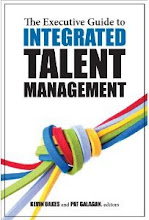In part 1 of this post I described the typical data and technology oriented approach to HR analytics and then ran out of space sharing my personality analysis from IBM Watson.
You can do analytics this way, but lots of organisations don’t have the data or technology. And even if you do, I think you need to combine with my way too.
But that's not the only way of doing things. It is technology and data which is causing change in analytics but it’s not the best place to start doing analytics.
Another of Thursday's speakers noted that most of our analytics are transactional not strategic. But we understand the value of strategic analysis so why not do this instead? I therefore suggest that analytics should really be based on strategy, questions and insight.
So yes, it is the question which is important, and these questions should come from your strategy.
Importantly, identifying the right strategic questions isn't going to be about listening to the questions the business is asking – they won’t know what they need to know, at least not as well as HR can do. And it isn’t just about understanding the way the business operates, it’s also about having deep insight into how people can be developed, motivated and aligned etc.
The key to doing it is plotting your HR strategy out as a value chain, a bit like the balanced business scorecard / business strategy map. I use a value chain that is the framework used in the CIPD's Valuing Your Talent work. However, the reason that it’s important is the fact it’s a value chain, not that it provides standardised measures (I'll post again later why that's a distraction).
There are four reasons for suggesting this:
- It helps clarify and communicate your HR strategy. This is important because the real difficulty in doing analytics isn't the measuring, the data cleaning or the statistics. Instead of this it's being clear about what you're trying to do and therefore what you need to know. The value chain format helps this to happen.
- It focuses on outcomes as well as activities and as well as the business. As I noted earlier, you need to understand and provide insights into people not just the business.
- It helps identifies how each of these objectives can be measured, or better, assessed - hence my focus on evidence not just metrics.
- It makes predictive or at least descriptive analytics easier.
Descriptive analytics is simply looking back up the value chain trying to work out why something has or hasn't happened, ie doing root cause analysis. You won't necessarily have data for all of these potential root causes but basing descriptive analytics on a strategy map means that at least you're looking at the most important things and also that you are more likely to already have good data (at least on the outcome and the main relationship with this, since you will already be measuring what's on the strategy map).
Predictive analytics can include several different things. However to be worthy of a different name I think it has to involve more than understanding data relationships which have existed in the past and then trying to extrapolate these into the future, especially as with increasing complexity this is getting harder to do. To me, it should involve looking further down the value chain at the consequences of particular actions which could or could not be taken. I call this branch effect analysis (the opposite of analysing root causes).
The issue with this is that even if you can extrapolate into the future you might not have the data to do this, particularly if you're trying something new. So predictive analytics may need to be based upon:
- Continual case (start to measure now to do analytics later)
- Comparative case (use benchmarking and research to show benefits other organisations have achieved)
A lot of maturity curves suggest may take 10 years from start of the journey to doing predictive analytics, after jumping over or through a brick wall. It doesn’t have to take that long – the value chain is the key to being able to do it now.
So there you go. You might now better understand why Watson thinks Im authority challenging and somewhat inconsiderate (at least to prevailing wisdom)! But I hope you will have found some of these ideas useful too.




























